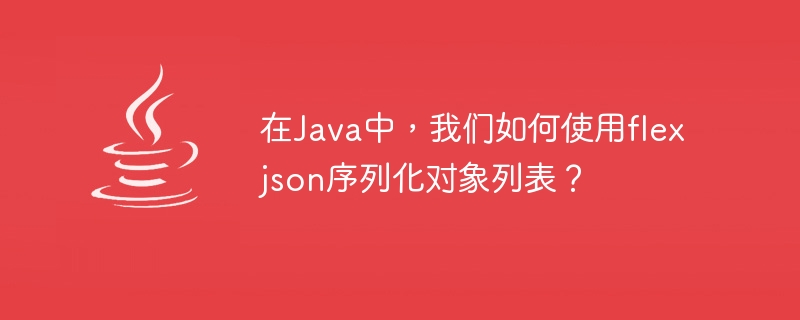In Java, how can we serialize a list of objects using flexjson?

Flexjson is a lightweight library for serialization and deserializationJava Objects > and come from JSON format. We can serialize the object list using the serialize() method of the JSONSerializer class. This method can perform shallow serialization on the target instance. We need to pass a list of objects of type List as a parameter to the serialize() method.
Syntax
public String serialize(Object target)
Example
import flexjson.JSONSerializer;
import java.util.*;
public class JsonSerializeListTest {
public static void main(String[] args) {
JSONSerializer serializer = new JSONSerializer().prettyPrint(true); // pretty print JSON
Student s1 = new Student("Raja", "Ramesh", 28, "Hyderabad");
Student s2 = new Student("Suresh", "Kumar", 30, "Chennai");
Student s3 = new Student("Surya", "Krishna", 35, "Pune");
List<Student> students = Arrays.asList(s1, s2, s3);
String jsonStr = serializer.serialize(students);
System.out.println(jsonStr);
}
}
// Student class<strong>
</strong>class Student {
private String firstName;
private String lastName;
private int age;
private String address;
public Student() {}
public Student(String firstName, String lastName, int age, String address) {
super();
this.firstName = firstName;
this.lastName = lastName;
this.age = age;
this.address = address;
}
public String getFirstName() {
return firstName;
}
public String getLastName() {
return lastName;
}
public int getAge() {
return age;
}
public String getAddress() {
return address;
}
public String toString() {
return "Student[ " +
"firstName = " + firstName +
", lastName = " + lastName +
", age = " + age +
", address = " + address +
" ]";
}
}Output
[
{
"address": "Hyderabad",
"age": 28,
"class": "Student",
"firstName": "Raja",
"lastName": "Ramesh"
},
{
"address": "Chennai",
"age": 30,
"class": "Student",
"firstName": "Suresh",
"lastName": "Kumar"
},
{
"address": "Pune",
"age": 35,
"class": "Student",
"firstName": "Surya",
"lastName": "Krishna"
}
]The above is the detailed content of In Java, how can we serialize a list of objects using flexjson?. For more information, please follow other related articles on the PHP Chinese website!

Hot AI Tools

Undresser.AI Undress
AI-powered app for creating realistic nude photos

AI Clothes Remover
Online AI tool for removing clothes from photos.

Undress AI Tool
Undress images for free

Clothoff.io
AI clothes remover

AI Hentai Generator
Generate AI Hentai for free.

Hot Article

Hot Tools

Notepad++7.3.1
Easy-to-use and free code editor

SublimeText3 Chinese version
Chinese version, very easy to use

Zend Studio 13.0.1
Powerful PHP integrated development environment

Dreamweaver CS6
Visual web development tools

SublimeText3 Mac version
God-level code editing software (SublimeText3)

Hot Topics
 1378
1378
 52
52
 Perfect Number in Java
Aug 30, 2024 pm 04:28 PM
Perfect Number in Java
Aug 30, 2024 pm 04:28 PM
Guide to Perfect Number in Java. Here we discuss the Definition, How to check Perfect number in Java?, examples with code implementation.
 Random Number Generator in Java
Aug 30, 2024 pm 04:27 PM
Random Number Generator in Java
Aug 30, 2024 pm 04:27 PM
Guide to Random Number Generator in Java. Here we discuss Functions in Java with examples and two different Generators with ther examples.
 Weka in Java
Aug 30, 2024 pm 04:28 PM
Weka in Java
Aug 30, 2024 pm 04:28 PM
Guide to Weka in Java. Here we discuss the Introduction, how to use weka java, the type of platform, and advantages with examples.
 Smith Number in Java
Aug 30, 2024 pm 04:28 PM
Smith Number in Java
Aug 30, 2024 pm 04:28 PM
Guide to Smith Number in Java. Here we discuss the Definition, How to check smith number in Java? example with code implementation.
 Java Spring Interview Questions
Aug 30, 2024 pm 04:29 PM
Java Spring Interview Questions
Aug 30, 2024 pm 04:29 PM
In this article, we have kept the most asked Java Spring Interview Questions with their detailed answers. So that you can crack the interview.
 Break or return from Java 8 stream forEach?
Feb 07, 2025 pm 12:09 PM
Break or return from Java 8 stream forEach?
Feb 07, 2025 pm 12:09 PM
Java 8 introduces the Stream API, providing a powerful and expressive way to process data collections. However, a common question when using Stream is: How to break or return from a forEach operation? Traditional loops allow for early interruption or return, but Stream's forEach method does not directly support this method. This article will explain the reasons and explore alternative methods for implementing premature termination in Stream processing systems. Further reading: Java Stream API improvements Understand Stream forEach The forEach method is a terminal operation that performs one operation on each element in the Stream. Its design intention is
 TimeStamp to Date in Java
Aug 30, 2024 pm 04:28 PM
TimeStamp to Date in Java
Aug 30, 2024 pm 04:28 PM
Guide to TimeStamp to Date in Java. Here we also discuss the introduction and how to convert timestamp to date in java along with examples.
 Java Program to Find the Volume of Capsule
Feb 07, 2025 am 11:37 AM
Java Program to Find the Volume of Capsule
Feb 07, 2025 am 11:37 AM
Capsules are three-dimensional geometric figures, composed of a cylinder and a hemisphere at both ends. The volume of the capsule can be calculated by adding the volume of the cylinder and the volume of the hemisphere at both ends. This tutorial will discuss how to calculate the volume of a given capsule in Java using different methods. Capsule volume formula The formula for capsule volume is as follows: Capsule volume = Cylindrical volume Volume Two hemisphere volume in, r: The radius of the hemisphere. h: The height of the cylinder (excluding the hemisphere). Example 1 enter Radius = 5 units Height = 10 units Output Volume = 1570.8 cubic units explain Calculate volume using formula: Volume = π × r2 × h (4




